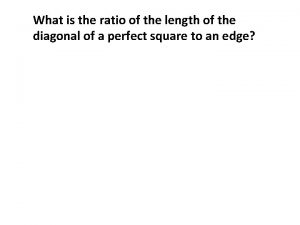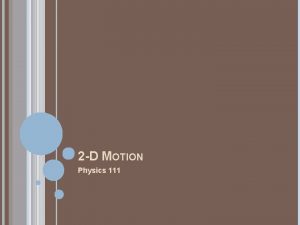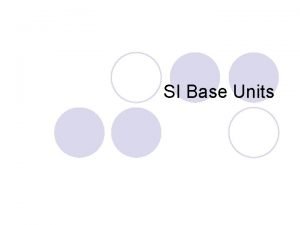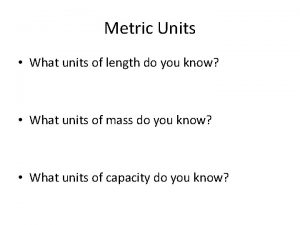Units of length Early units of length were





- Slides: 5

Units of length • Early units of length were associated with the human body. • The foot was originally defined to be the length of the royal foot of King Louis XIV. • These units are not reproducible.

A Earth C The Meter In 1792 the meter was defined to be one ten-millionth of the distance from the north pole to the equator. Equator B For practical reasons the meter was later defined as the distance between two fine lines on a standard meter bar made of platinum-iridium. Wavelength of Light Speed of Light In 1960, a new standard for the meter, based on the wavelength of light, was adopted. Specifically, the standard for the meter was redefined to be 1 650 763. 73 wavelengths of a particular orange-red light emitted by atoms of krypton-86 (a particular isotope of krypton) in a gas discharge tube. Since 1983 the meter is defined as the length traveled by light in vacuum during the time interval of 1/299792458 of a second. The reason why this definition was adapted was that the measurement of the speed of light had become extremely precise.

The Second Initially the second was defined as follows: The problem with this definition is that the length of the day is not constant as is shown in the figure. For this reason, since 1967 the second is defined as the time taken by 9192631770 light oscillations of a particular wavelength emitted by a cesium-133 atom. This definition is so precise that it would take two cesium clocks 6000 years before their readings would differ by more than 1 second. http: //tf. nist. gov/cesium/fountain. htm

The Kilogram The SI standard of mass is a platinum-iridium cylinder shown in the figure. The cylinder is kept at the International Bureau of Weights and Measures near Paris and assigned a mass of 1 kilogram. Accurate copies have been sent to other countries. A Second Mass Standard: The masses of atoms can be compared with one another more precisely than they can be compared with the standard kilogram. For this reason, we have a second mass standard. It is the carbon-12 atom, which, by international agreement, has been assigned a mass of 12 atomic mass units (u).

Density As we shall discuss further in Chapter 14, the density ρ of a material is the mass per unit volume: Densities are typically listed in kilograms per cubic meter or grams per cubic centimeter. The density of water (1. 00 gram per cubic centimeter) is often used as a comparison. Fresh snow has about 10% of that density; platinum has a density that is about 21 times that of water.









